Lately I’ve been having a lot of conversations around investment terms with searchers, as well as investors.
About 15 years ago, I interned at a search fund. And, over the last few years, I’ve started to invest in the asset class going direct as well as through funds of search funds.
Investing in search funds is a great way to scratch my entrepreneurial itch, extremely rewarding when a searcher finds success, and can be economically rewarding too.
This post is my attempt to share thoughts on self funded search economics in an effort to contribute to the search fund community, get feedback on my thinking from a wider audience, and of course meet more people who are doing searches/investing and may want to collaborate (please feel free to reach out!).
You can watch a video of me explaining this model here, and download the excel here:

Enterprise Value
The standard finance equation is enterprise value = debt + stock – cash. Enterprise value is how much the company itself is worth. Many times people confuse it with how much the stock is worth and find the “minus cash” part of this really confusing.
So, you can rearrange this equation to make it stock = enterprise value – debt + cash. Make more sense now?
Enterprise value is just how much you’re willing to pay for the company (future cash flows, intellectual property, etc), not the balance sheet (debt and cash).
Most investors and searchers think about the EBITDA multiple of a company on an enterprise value basis because they’ll be buying it on a cash free, debt free basis. It becomes second nature to think about EBITDA multiples and know where a given business should fall given scale, industry, etc.
However, I believe this second nature way of thinking of things can be a massive disadvantage to investors given the way EV and multiples are talked about in our community currently.
Sources of capital, the typical way to calculate enterprise value for self funded searchers
If you’ve ever looked at or put together a teaser for a self funded search deal, you will notice that the deal value is equal to the sum of the sources of capital minus deal fees and cash to the balance sheet.
As a simple example, if there is $4 mm of debt to fund the deal, $1 mm of equity, and $200k of deal fees, the enterprise value = $4 mm + $1 mm – 200k = $4.8 mm.
We’ll use slightly more complex numbers in our example: If a searcher is taking a $3.2 mm SBA loan, $850k seller note, putting in $120k themselves, getting $350k of equity from the seller, a $500k earnout, and $1.2 mm of equity financing minus $350k to the balance sheet and $250k of deal fees, then the enterprise value will be $5.62 mm.
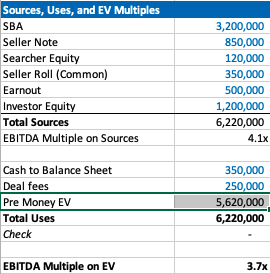
Our example company has $1.5 mm of EBITDA, so the EBITDA multiple is 3.7x. This is a pretty attractive acquisition multiple for a business that meets traditional search criteria (recurring revenues, fragmented competition, high gross margins, low customer concentration, etc).
If you’re seeing a search fund deal for the first time, the headline of “we’re buying a decent company for 3.7x, and replacing a tired owner with a hungry operator” is pretty exciting!
However, if you’re an investor, there is some nuance to this enterprise value number and the true EBITDA multiple you are investing in.
The trick with self funded enterprise value
The security that most self funded search investors get in a deal is participating preferred stock with a paid in kind dividend. This means when there’s an exit, you get your money back before any other equity holder, then get a certain percent of the business, and whatever dividend you’ve been owed in the interim accrues to your principle.
It’s a really favorable security for the investor, and one that is basically impossible to get in VC where straight preferred stock is much more common (no pun intended).
The key terms are what percent of common equity does this security convert into after the originally principal is paid back, and what is the dividend.
The share of common equity the investor group will get typically ranges from 10-50% of the total common stock. The dividend rate is usually 3-15%. The average I’m seeing now is around 30% and 10% for common and dividends respectively.
The strange this about the enterprise value quoted to investors in a teaser/CIM is that it doesn’t change as the percent of common changes, even though this has large implications for how much the common equity is worth and the value investors receive.
For example, I may get a teaser where the sources of investment – cash to balance sheet – deal fees = $3.7 mm for a $1 mm EBITDA company, which would imply a 3.7X EBITDA multiple. Let’s say the searcher is offering investors 30% of the common and a 10% dividend.
Let’s now say that the searcher is having a tough time raising capital and changes their terms to 35% of common and a 12% dividend. Does the effective enterprise value change for investors? I would argue yes, but I would be surprised to see it changed in the CIM/teaser.
This isn’t a knock on searchers or the search fund community. It’s just kind of how things are done, and I think this is mostly because it’s really hard to think about how the enterprise value has changed in this scenario.
However, the natural way of using EBITDA multiples to think about value for a business that is so common in PE/SMB can be extremely misleading for investors here. You may be thinking 3.7X for this type of business is a great deal! But, what if the security you’re buying gets 5% of the common?
If you’re in our world, you may counter this point by saying most searchers will also supply a projected IRR for investors in their CIM. However, IRR is extremely sensitive to growth rate, margin expansion, and terminal value. While the attractiveness of the security will be reflected, it can be greatly overshadowed by lofty expectations.
To get more clarity and have a slightly different mental model on the effective price investors are paying for this business, let’s go back to basics. Enterprise value should be debt + preferred stock + common stock – cash.
We know the values of each of these numbers, except the common. So, the main question here becomes: how much is the common equity worth?
Calculating value of common equity for self funded search funds
Equity value for most search fund deals = preferred equity from investors + the common equity set aside for the searcher and sometimes also advisors, board, seller.
We know that the preferred equity is investing a certain amount for a certain amount of common equity. The rub is that they are also getting a preference that they can take out before any common equity gets proceeds, and they are getting a dividend.
So, the exercise of valuing the common equity comes down to valuing the preference and dividend.
In my mind, there are three approaches:
- The discount rate method where you take the cash flows you’ll get in the future from the pref/dividends and discount them back at the discount rate of your choice. I am using 30% in my model which I believe accurately compensates investors for the risks they are taking in a small, highly leveraged investment run by an unproven operator. If you believe in efficient markets, this number also fits as it mirrors the historical equity returns as reported by the Stanford report, with a slight discount given this asset class has clearly generated excess returns relative to other assets on a risk adjusted basis, hence interest in these opportunities from an expanding universe of investors.
- The second method is to calculate how much money you’d get from your preference and dividends, taking into account that per the Stanford study around 75% of search funds will be able to pay these sums, and then discount these cash flows back at a rate more in line with public equities (7% in my model). This yields a much higher value to the preference/dividend combo, and therefore lowers the implied value of the common equity.
- The last method is to just say nope, there is no value to the preference and dividend. I need them and require them as an investor, but they are a deal breaker for me if they aren’t there, and therefore they don’t exist in my math. This of course makes no logical sense (you need them, but they also have no value?), but I’ve left it in as I think many investors probably actually think this way and it creates a nice upper bound on the enterprise value. Side note, as with obstinate sellers, jerk investors are usually best avoided.
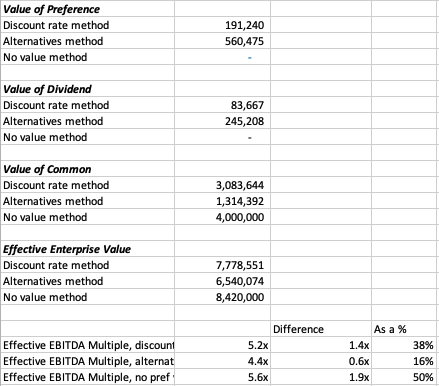
In our example, you can see a breakdown of the preference value, dividend value, and therefore common value and enterprise value for this deal.
In each case, the effective EBITDA multiple moves from 3.7x to something much higher (see the last 3 lines).
There are some simplifying assumptions in the model (no accruing dividend, all paid in last year), and some weird stuff that can happen (if you make the hold time long and the dividend greater than the 7% equity discount rate, the value of the dividend can get really big).
These flaws aside, I think this creates a nice framework to think through what the common is actually worth at close, and therefore what enterprise value investors will be paying in actuality.
It’s worth noting that the whole point of this is to benchmark the value you’re getting relative to market transactions in order to understand where you want to deploy your capital.
This creates a method to translate cash flow or EBITDA multiples of other opportunities on an apples to apples basis (if only there were a magical way to translate the risk associated with each as well!).
Another note, we could calculate the value of the common to be what this asset would trade at market today in a well run auction process minus any obligations (debt, preference, seller financing). However, I think that understates the option value inherent in this equity, a value that is only realized when a new manager takes over with more energy and know how.
There is a finance nerd rational for this. If you plot the value of equity in a leveraged company on a chart, it mirrors the payout of a call option. In both cases, the value of the security increases at a certain inflection point: when the value of equity rises above the strike price in an option, and when the enterprise value of a company rises above the debt level in a levered company.
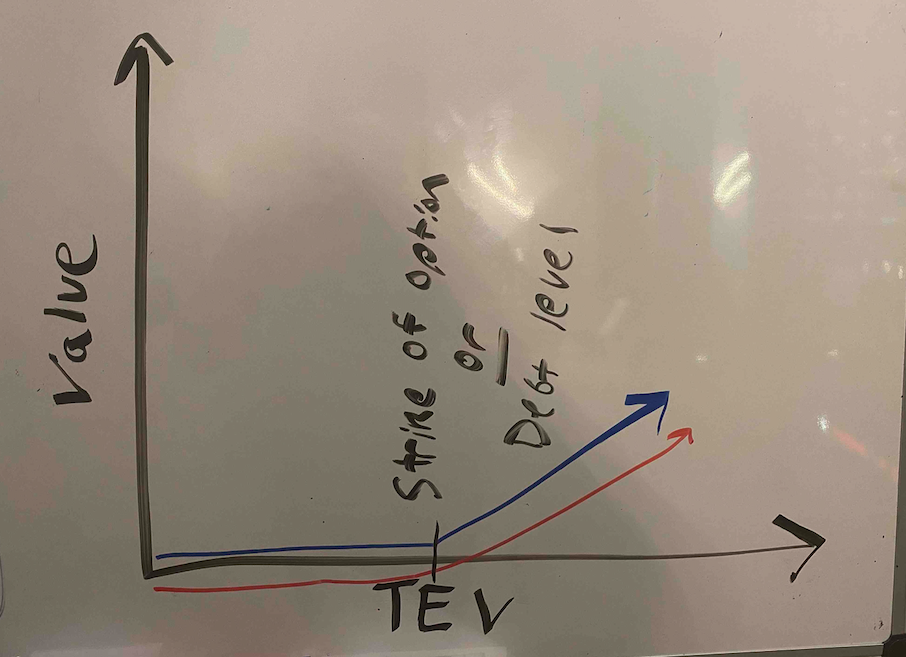
The common equity of a highly levered company can therefore be valued by a similar methodology as the call option: Black Scholes. If you remember back to finance class, increasing volatility will increase the value of an option.
In the search fund case, we’ve (hopefully) increased the (upside) volatility and therefore create more value than simply selling the company today.
A few more thoughts on investor economics
There are a few other ways to think about the economics you get as an investor to best understand if this is the deal for you.
First, you may want to think about how much your investment will be worth day 1. The key lever in this model is what discount this company is being bought for relative to fair market value. For example, the searcher may have proprietary sourced a great company and is buying it for 25% below what it would trade at in a brokered auction.
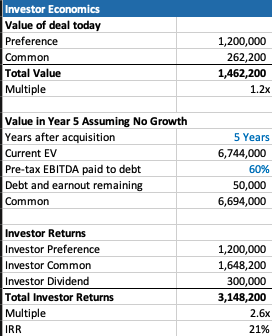
This is very much a “margin of safety” philosophy on things. Same with the calculation on how much you’ll receive in year 5 (after QSBS hits) assuming no growth in the business.
The only problem with each of these calculations is that they never play out in practice. Most companies don’t just stay the same, you’re either in a rising tide or you’re in trouble. And, you’re almost never going to sell in year 1, and definitely not for a slight premium to what it was bought for.
However, if your investment is worth 30% higher day one, and you can make a 20% IRR assuming nothing too crazy happens either way in the business, that’s not a bad place to start. Add in a strong searcher, decent market, some luck, and you’re off to the races.
Thoughts on searcher economics
A lot of this post has considered things from the investor perspective as my main quandary was related to how to create an EBITDA multiple that made sense for investors.
However, the point of this post is not to say searchers are misrepresenting or being unrealistic with their terms. In fact, I think it’s quite logical that self funded searchers capture the massive economic value that they do.
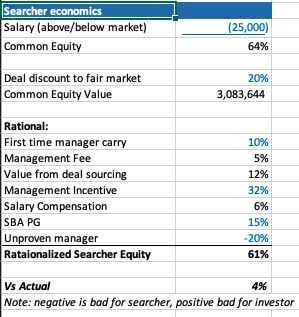
There are many reasons why self funded searchers deserve the lion share of the common equity.
First, they are providing a nice service of giving investors a positive expected value home to park their money with much lower correlation to the market than other asset classes ($1 mm EBITDA companies don’t see lots of multiple contraction/expansion throughout cycles).
Most money managers that fit that criteria are taking a 2/20, of course they also usually have a track record. So, I’ve used a 10% carry in my model, but stuck to 2% annual management fee.
The searcher spent a lot of time, and probably money, finding this company. That’s a lot of value, especially if it’s a below market price. They should be able to capture a lot of the value in finding a below market deal.
The searcher may be taking a below market salary, and needs to get comped like any CEO, with stock options. In my example model I have $1 mm of stock vesting over the hold period, as well as extra comp for taking a below market salary.
Searchers are also usually putting their financial standing at risk by taking a personal guarantee on the bank/SBA loan. This is really tough to put a number on, as is the last line in my framework where searchers are dinged for lack of experience. Like any good model, you need a few lines that you can fudge to make the math work 🙂
What you do think?
I’m shocked that I wrote all this. I was going to type a few paragraphs and a quick excel. However, putting this to paper has been a great exercise for me to sharpen my thinking.
Now I’d like you to help me further. Where do you think this should be changed in this framework? How do you think about things from the investor and/or searcher side?
Feel free to shoot me a note if you have thoughts (even just to tell me I’m being way too academic with this, which I actually agree with).
Lastly, a post like this is really a trap I’m putting on the internet to catch any like minded people in so that we can figure out ways to collaborate now or in the future. So, at the very least, connect with me on LinkedIn 🙂

Your style is very unique compared to other people I have read stuff from.
I appreciate you for posting when you’ve got the opportunity,
Guess I will just book mark this blog.
Hi would you mind letting me know which webhost you’re using?
I’ve loaded your blog in 3 completely different browsers and I must say this blog loads a lot quicker then most.
Can you recommend a good web hosting provider at a fair price?
Kudos, I appreciate it!
Our invoices range frokm credit card payments,
mortgages, phones, and utility payments. Fundamentally, loan issuers would come for their money if you don’t make payments on time.
Every collection adds to a credit report and will ccripple your
loan negotiation ability. At the latest FICO models, paid collections will not hurt your score, but unpaid ones
certainly will. If among your accounts goes into group,
your credit score plummets depending onn a few elements.
If your score is high, you’ll los more points than someone with a
handful of points. If you miss a payment, your creditor would report it to the
agencies as”payment” However, if you fail to pay penalties or bbring your account to standing, you
may encounter a collection. Immediately you experience a
set; your credit score will fall drastically. Resolving a set is a painstaking procedure,
hence making timely payments is obviously an ideal way.
Feel free to surf to my web page – Credit Tricks
Great beat ! I wish to apprentice while you amend your
website, how can i subscribe for a blog site? The account helped me
a applicable deal. I had been a little bit acquainted of this your broadcast provided brilliant clear
concept
Good day! I simply would like to give you a big thumbs up for
the great info you’ve got right here on this post.
I’ll be returning to your web site for more soon.
Hey there! Would you mind if I share your blog with my myspace group?
There’s a lot of people that I think would really appreciate
your content. Please let me know. Thank you
Thanks for your personal marvelous posting! I genuinely enjoyed reading it, you might be a
great author.I will be sure to bookmark your blog and may come back someday.
I want to encourage you continue your great posts, have a nice weekend!
Asking questions are genuinely pleasant thing if you are not understanding
anything totally, but this article offers nice understanding yet.
This article will assist the internet users for setting up new blog or even a
blog from start to end.
I’m very pleased to discover this site. I want to to thank
you for ones time for this fantastic read!!
I definitely really liked every part of it and i also have you book-marked to check out new things in your site.
Thanks for finally writing about > Thoughts on Search Fund
Economics – Phil Strazzulla's Blog < Liked it!
I was recommended this website by my cousin. I’m not sure whether this post is written by him as nobody else know such detailed about
my difficulty. You are wonderful! Thanks!
Informative article, totally what I wanted to find.
Excellent goods from you, man. I’ve understand your stuff previous to and you’re just extremely fantastic.
I actually like what you’ve acquired here, really like what you are saying and the way in which you
say it. You make it enjoyable and you still take care of to keep
it smart. I can’t wait to read much more from you. This is actually a tremendous website.
If some one desires expert view regarding blogging then i advise him/her to go to see this
webpage, Keep up the pleasant work.
Whats up are using WordPress for your site platform? I’m new to the blog world but I’m
trying to get started and set up my own. Do you
need any html coding knowledge to make your own blog?
Any help would be really appreciated!
What’s up Dear, are you really visiting this website daily, if so after that you will without doubt take pleasant know-how.
It was a great treatment center, they helped me get my life back on track.
The facility is awesome and the people that work there are in recovery so
it was so easy to feel like I belong there. They were a huge support through the process as well.
Very grateful!
Incredible! This blog looks just like my
old one! It’s on a entirely different topic but it
has pretty much the same layout and design. Great choice
of colors!
หวยออนไลน์ที่เปิดให้บริการ หวยฮานอย หวยฮานอยVIP และ หวยฮานอยพิเศษ
หวยฮานอย คือ หนึ่งในหวยที่เป็นที่นิยมอย่างสูงรองจากหวยรัฐไทย มีอยู่ 3 หวยที่เปิดให้บริการโดยเว็บหวยนาคาได้แก่ หวยฮานอย หรือ ฮานอยธรรมดา หวยฮานอยVIP หรือ ฮานอยVIP และ หวยฮานอยพิเศษ หรือ ฮานอยพิเศษ โดยหวยฮานอยทั้งสามออกรางวัลทุกวัน
I read this paragraph fully regarding the comparison of latest and previous technologies, it’s remarkable article.
I read this article completely regarding the comparison of most
recent and earlier technologies, it’s awesome article.
really interesting review. In addition visit the below site that
can be played slot. This page has received level of popularity from slot pulsa online gambling
house some others in Dalam negri. At this time there are
usually various exciting promos as you join currently.
I like what you guys are usually up too. This kind of clever work and exposure!
Keep up the good works guys I’ve incorporated you guys to blogroll.
Hi there would you mind sharing which blog platform you’re working
with? I’m planning to start my own blog in the near future but I’m
having a hard time choosing between BlogEngine/Wordpress/B2evolution and Drupal.
The reason I ask is because your design seems different then most blogs and I’m
looking for something unique. P.S Apologies for getting off-topic but
I had to ask!
There’s definately a great deal to learn about this subject.
I like all of the points you have made.
Your means of telling everything in this paragraph is truly
nice, every one be able to effortlessly understand it, Thanks
a lot.
I all the time used to read article in news papers but
now as I am a user of internet so from now I am using net for content, thanks to web.
I have been browsing online more than 3 hours today, yet I never
found any interesting article like yours. It’s pretty worth enough for me.
In my opinion, if all site owners and bloggers made good content as you
did, the internet will be much more useful than ever before.
I have to thank you for the efforts you have put in writing this site.
I really hope to view the same high-grade blog posts from you later on as well.
In truth, your creative writing abilities has motivated me to get my
own blog now 😉
I like the valuable info you provide in your articles.
I’ll bookmark your blog and check again here frequently.
I’m quite certain I will learn plenty of new stuff right here!
Best of luck for the next!
This design is incredible! You definitely know how to keep a reader entertained.
Between your wit and your videos, I was almost moved to start
my own blog (well, almost…HaHa!) Wonderful job. I really enjoyed what you had to say, and more than that, how you presented it.
Too cool!
Everyone loves what you guys are up too. Such clever work and reporting!
Keep up the great works guys I’ve you guys to my blogroll.
If you are going for best contents like myself,
simply pay a quick visit this site daily because it provides feature contents, thanks
For most recent information you have to pay a quick
visit world-wide-web and on web I found this web page as
a most excellent website for most recent updates.
Amazing things here. I am very happy to look your article.
Thanks so much and I’m looking forward to touch you.
Will you please drop me a mail?
Hello There. I found your blog using msn. This
is an extremely well written article. I will be sure to bookmark it and return to read more of
your useful information. Thanks for the post.
I’ll certainly return.
Peculiar article, exactly what I was looking for.
Great info. Lucky me I recently found your blog by accident
(stumbleupon). I’ve saved it for later!
My programmer is trying to convince me to move to .net from PHP.
I have always disliked the idea because of the expenses.
But he’s tryiong none the less. I’ve been using Movable-type on several websites for about a year and am
nervous about switching to another platform. I have heard great things about blogengine.net.
Is there a way I can transfer all my wordpress content into it?
Any help would be really appreciated!
Hello there! Do you know if they make any plugins to protect against hackers?
I’m kinda paranoid about losing everything I’ve worked hard on.
Any suggestions?
Good day! Do you know if they make any plugins to safeguard against hackers?
I’m kinda paranoid about losing everything I’ve worked hard on. Any suggestions?
Keep on writing, great job!
Excellent weblog right here! Also your site loads up fast!
What host are you the use of? Can I get your associate link in your host?
I wish my website loaded up as fast as yours lol
Every weekend i used to visit this site, because i want enjoyment, as this this site
conations in fact nice funny stuff too.
Touche. Solid arguments. Keep up the good work.
Heya i am for the first time here. I came across this board and I find It truly useful & it helped me out
much. I hope to give something back and help others like you aided me.
Hurrah! At last I got a web site from where I can in fact
take useful data concerning my study and knowledge.
Hi, i feel that i saw you visited my site thus i came to return the choose?.I’m
attempting to find issues to enhance my web site!I guess its adequate to use a few of your ideas!!
Usually I do not read post on blogs, however
I wish to say that this write-up very compelled
me to take a look at and do it! Your writing taste has been amazed me.
Thanks, very nice post.